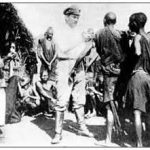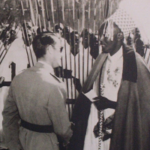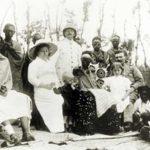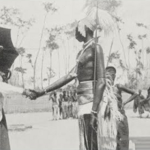Clientship In Mid-Nineteenth-Centery KINYAGA
Of those patron-client ties that did exist during this period, three major types can be distinguished: direct clientship to the king, umuheto clientship, and land clientship. In subsequent periods, umuheto was abolished, land clientship was substantially altered, and direct clientship to the king was replaced by ties to administrative officials; in fact, royal client ties served as a wedge facilitating the later proliferation of client linkages with other officials.
Clientship to the king linked the local lineage directly with the royal court. Normally the client lineage sent an annual or biennial gift to the king (usually cattle), and one or two of its members would pay court at the king’s residence for part of each year. Among Kinyagans interviewed for this study, those who knew of any client ties in their lineage before the reign of Rwabugiri often described these as direct clientship to the king, sometimes claiming that their ancestors immigrated to Kinyaga as emissaries of the royal court. While perhaps influenced by considerations of prestige, many such claims are well-founded; it was in fact the policy of the royal court to send colonizers to peripheral areas, both to establish a political foothold and to reward the king’s men with grants of land. Where accounts do not cite evidence of an ancestor’s having been sent to Kinyaga by the king, they sometimes claim that the royal court had given cattle to the lineage. Some Kinyagans described in detail the type of linkages their ancestors had with the kings Rwogera or Gahindiro (father and grandfather of Rwabugiri), including gifts and services provided by the lineage as client.
However, to claim direct clientship to the king is sometimes to view this form of client tie as a residual category, one that must have existed in the absence of any other known client ties. Such claims may also reflect identitive commitment to the royal court by pioneers of the frontier region. Most important, since clientship to the king precluded the need for subordination to any intermediary authority, claims of this type imply an assertion of autonomy from local officials.
Umuheto was another form of clientship in which lineages participated as corporate groups. The role of umuheto groups in Kinyagan administrative structures has already been discussed, and we shall now consider the client characteristics of the institution. A major function of the umuheto tie in mid-nineteenth-century Kinyaga was to link client lineages to umuheto patrons living in central Rwanda. The patrons acted as “protectors” for the lineage’s cattle while they received certain prestations or services from their client lineages. Umuheto was thus in some ways a precursor of ubuhake cattle clientship, but there were important differences between the two client forms.
First, in Kinyaga ubuhake clientship most commonly linked an individual to his patron,while umuheto clientship normally linked a
lineage as a group, not as individuals, to an umuheto chief or his delegate. Second, ubuhake clientship as it was introduced to Kinyaga in the late nineteenth century involvtd the cession of a cow in usufruct from a patron to his client; umuheto clientship, on the other, hand, involved the gift of a cow at regular intervals from a client lineage to its umuheto patron.
This latter distinction was important. It means that umuheto clientship in Kinyaga was initially limited to lineages possessing cattle, since during the early years it was the client lineage which was the cattle donor. Moreover, in ubuhake the transfer of the cow from patron to client symbolized the dependency of the client and ultimately (at a later period) exposed his personal cattle to potential confiscation at the pleasure of the patron. In the early umuheto relationship, by contrast, a client’s personal cattle were rarely taken as long as the transfer of the cow was affected. In short, while originally they resembled each other the different forms of cattle transfer influenced the later evolution of the two institutions. While both became exploitative, ubuhake was adapted to broader and more arbitrary forms of exploitation.
Kagame’s study of social army organization indicates that new social armies were formed at the beginning of each new royal reign, but previous social armies normally retained their corporate status. The king appointed umuhèto chiefs, who were then authorized to select lineages or portions of lineages to be included in the new armies. The commonly accepted model of Rwandan administrative structures implies that all Rwandans were incorporated into social armies (umuheto groups). Clearly this situation had not been realized in pre-Rwabugiri Kinyaga. Many Kinyagans insist that umuheto did not become widespread in the region until the reign of Rwabugiri and after; even then, it affected only those lineages specifically selected for umuheto, not the entire population.
Data on the recruitment process before the reign of Rwabugiri are scanty, but generally informants attribute early umuheto clientship of a lineage to its wealth in cattle, or to the preservation by earlier immigrants to Kinyaga of umuheto ties that had been formed in their home regions. Their wealth in cattle as well as the higher status implied by their umuheto ties qualified such lineages as Tuutsi. As one Kinyagan put it, the chiefs of central Rwanda “sought to find a Tuutsi and his cattle;… each pursued the section of which he had received command and they looked for the cattle-owners.
The data available afford no examples of attempts to refuse umuheto clientship in the early- and mid-nineteenth century, though examples of such resistance are clearly remembered for later periods. There is a similar absence of data concerning potential conflict between different chefs who might have tried to select the same lineage.
For the reigns of Rwabugiri and Musinga information on the recruitment process and patterns of competition and conflict between patrons reveals tensions between umuheto patrons and other powerful officials -land chiefs and ubuhake patrons. During this later period, it was difficult for Kinyagans to refuse overtures from an umuheto patron or to avoid umuheto altogether. In these cases, success in recruitment of clients rested to an important extent on the relative political power of the potential patrons who sought to incorporate Kinyaga into the wider political arena of the Rwandan central court during and after the time of Rwabugiri.
Les données sur le processus de recrutement avant le règne de Rwabugiri sont rares, mais les informateurs attribuent généralement la clientèle précoce d’une lignée à sa richesse en bovins, ou à la préservation par les immigrants précédents du Kinyaga des liens noués au sein de leur région d’origine. Leur richesse en bétail ainsi que le statut plus élevé qu’impliquent leurs liens mutuels ont qualifié ces lignées de Tuutsi. Comme le dit un Kinyagan, les chefs du centre du Rwanda “cherchaient un Tuutsi et son bétail; […] chacun poursuivait la section dont il avait reçu le commandement et cherchait les propriétaires du bétail. Les données disponibles ne fournissent aucun exemple de tentative de refus de la clientèle au début et au milieu du XIXe siècle, bien que des exemples de cette résistance soient clairement gardés en mémoire pour des périodes ultérieures. Il existe une absence similaire de données sur les conflits potentiels entre différents chefs qui auraient pu essayer de sélectionner la même lignée. Pendant le règne de Rwabugiri et de Musinga, des informations sur le processus de recrutement, les modèles de concurrence et les conflits entre patrons révèlent des tensions entre les patrons d’umuheto et d’autres hauts fonctionnaires, chefs de terres et patrons d’ubuhake. Au cours de cette période ultérieure, il était difficile pour les Kinyagans de refuser les ouvertures d’un client d’umuheto ou d’éviter complètement d’umuheto. Dans ces cas, le succès du recrutement des clients reposait dans une large mesure sur le pouvoir politique relatif des clients potentiels qui cherchaient à incorporer le Kinyaga dans l’arène politique plus large de la cour centrale rwandaise pendant et après le règne de Rwabugiri.
Umuheto obligations were limited in scope. Most commonly, a client lineage was expected to send a cow to the umuheto patron at intervals of one or two years. The umuheto cow (inka y’umuheto)
symbolized the lineage’s submission to its patron and ensured the protection of the lineage’s cattle (imbaata).In addition to the umuheto cow, some client lineages perfomided annual courtship (gufata igihe) during which a representative of the lineage would spend some months of each year at the residence of the umuheto patron. Duties included accompanying the patron in his daily travels, repairing the fence of the patron’s residence, or serving him in other ways. The umuheto client lineage could also be called upon to send a member to fight in wars, should the social army be mobilized for active military service.
The ideal conduct of an umuheto chief consisted of a complex of obligations toward members of the social army, including intervention to aid a client accused of theft. Generosity in distribution of cattle was also a desirable quality. But the primary role of the umuheto patron was to protect the client lineage’s cattle. According to central court tradition, all cattle which would normally be considered personal property imbaata or ingwate cattle, obtained through marriage payment, gift, purchase, or reward for bravery in battle) were known as the “king’s cattle” (inka z’umwami), and hence could be confiscated by delegates of the king. From the perspective of the central court again, cattle belonging to members of a social army (umuheto client lineages) were supposed to be grouped in named “cattle armies,” also under the jurisdiction of the social army(umuheto) chief.
Kinyagan lineages associated with umuheto clientship tended not to be concemed with such distinctions. To them, the umuheto tie represented a type of insurance for the continued possession of their personal cattle. The “protection” afforded by the umuheto patron was usually indirect; so long as a lineage preserved good relations with its patron, no other chief would be likely to threaten the lineage’s cattle. But in cases where a member of a client lineage became involved in litigation over cattle, the umuheto patron was expected to intervene on his client’s behalf. Once established, the umuleto tie usually endured over several generations; the relationship which developed between an umuheto patron and members of his client lineage was one of mutual respect, often characterized by strong affective ties. Although Kinyagan client lineages were not prominent in the national political arena, their wealth, local status, and kin connections nevertheless gave them a favorable bargaining position in the client-patron relationship. The payments or services required of umuheto clients were moderate, and these responsibilities were shared by the lineage as a group. Because umuheto patrons of Kinyagan lineages in the mid-nineteenth century normally lived outside the local region, they found it difficult to impose overly burdensome exactions in any consistent fashion
https://uk.amateka.net/clientship-in-mid-nineteenth-centery-kinyaga/https://uk.amateka.net/wp-content/uploads/2020/05/guerrier.jpghttps://uk.amateka.net/wp-content/uploads/2020/05/guerrier-150x150.jpgChanges and ColonialismOf those patron-client ties that did exist during this period, three major types can be distinguished: direct clientship to the king, umuheto clientship, and land clientship. In subsequent periods, umuheto was abolished, land clientship was substantially altered, and direct clientship to the king was replaced by ties to administrative...BarataBarata rpierre@ikaze.netAdministratorAMATEKA | HISTORY OF RWANDA




